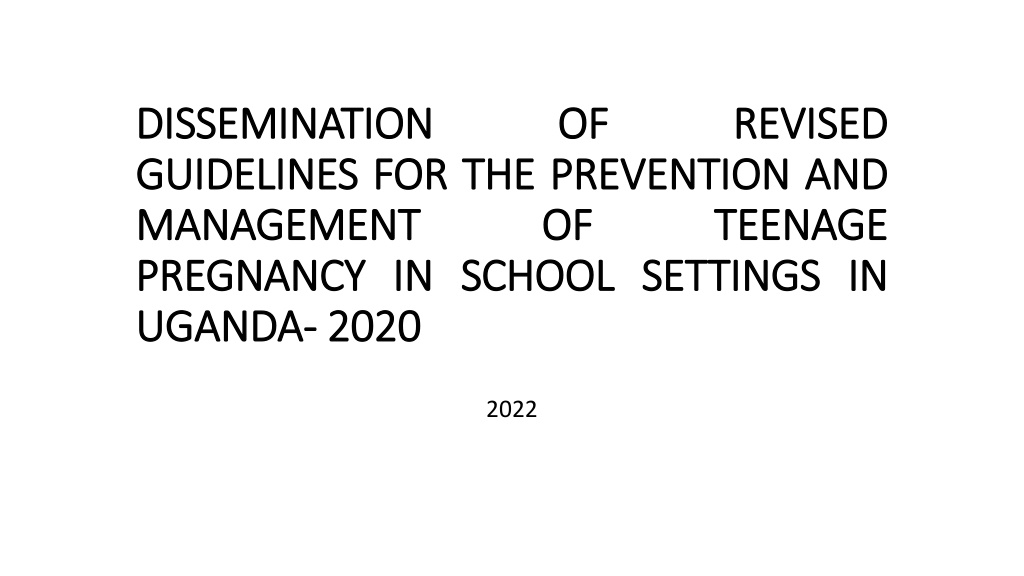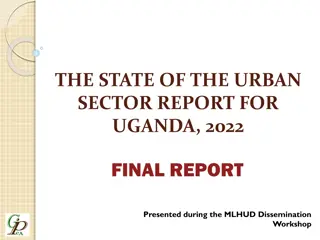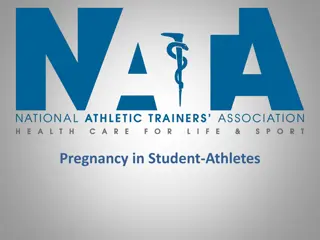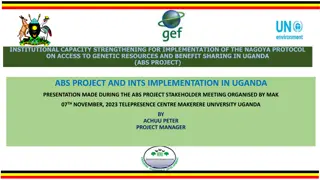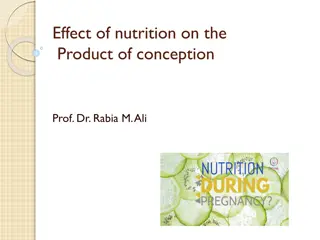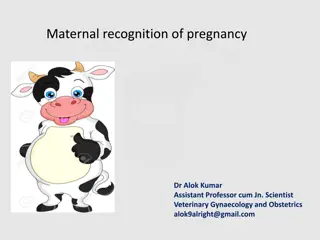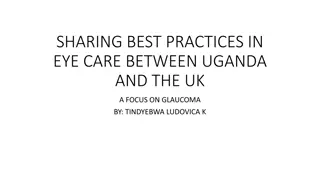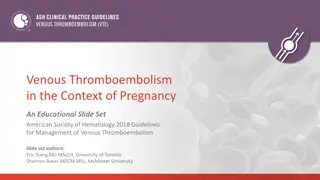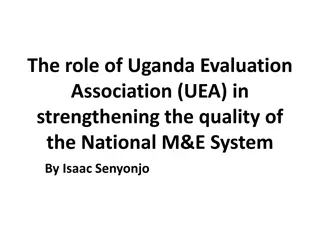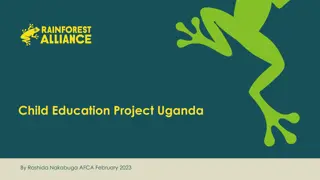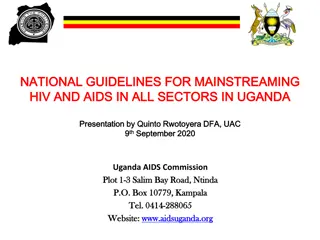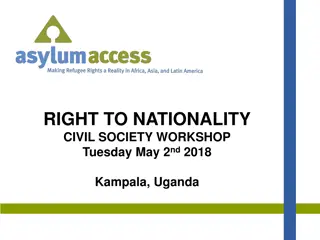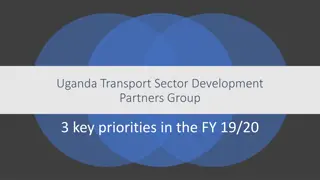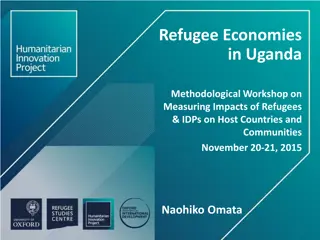Guidelines for Managing Pregnancy in School Settings in Uganda - 2020-2022
Education is a fundamental factor for human development, with guaranteed rights in Uganda. The COVID-19 pandemic has worsened vulnerabilities, especially for adolescent girls, leading to increased teenage pregnancies. Specific districts in Uganda have been greatly impacted. Education for women and girls plays a vital role in reducing fertility rates, delaying marriage, and improving overall health outcomes.
Download Presentation

Please find below an Image/Link to download the presentation.
The content on the website is provided AS IS for your information and personal use only. It may not be sold, licensed, or shared on other websites without obtaining consent from the author. Download presentation by click this link. If you encounter any issues during the download, it is possible that the publisher has removed the file from their server.
E N D
Presentation Transcript
DISSEMINATION DISSEMINATION GUIDELINES GUIDELINES FOR MANAGEMENT MANAGEMENT PREGNANCY PREGNANCY IN IN SCHOOL UGANDA UGANDA- - 2020 2020 OF OF PREVENTION AND OF OF TEENAGE TEENAGE SCHOOL SETTINGS SETTINGS IN IN REVISED REVISED AND FOR THE THE PREVENTION 2022
Introduction: Introduction: Education is universally acknowledged as a key factor for human development. The right to education is constitutionally guaranteed for every person in Uganda irrespective of sex or other economic and social standing (Constitution of the Republic of Uganda, Article 20). Education for women and men, girls and boys widens opportunities, choices, incomes, and therefore plays a key role in lifting communities out of poverty.
Background Covid-19 has united the world in an incredibly unique way. While it is true that everyone has struggled with the fallout of this global pandemic, it has had more serious consequences on some of the most vulnerable populations. Unfortunately, adolescent girls have been among the most adversely affected and for some, life has become downright dangerous. schools were closed with no hopes of reopping which affected their morale and further reduced their concentration on their careers. Without the support system of teachers and school administrators, many girls were left vulnerable to teenage pregnancy, early childhood marriage and gender-based violence, among other devastating effects of Covid-19.
Background Background The country was generally hit BUT there are some specific districts that were highly hit by the teenage pregnancy incidences. The six regions with the highest numbers of teenage pregnancies were; Busoga: the most affected district were Kamuli (6,535) and Mayuge (6,205 teenage pregnancies). North Central: the most affected districts were Mukono (5,535) and Luweero (4,545). Lango: (Oyam 6,449 and Lira 4,697).South Central: (Wakiso 10,439 and Rakai, 2711). West Nile: (Arua 4,705 and Yumbe 3,973), Rwenzori: Kasese (7,319) and Kyenjojo (4,341). (UNFPA report 2021)
Introduction - For women and girls, education is known to contribute to the lowering of fertility rates, delay of the age of marriage, leads to smaller family sizes and significant reduction in infant and maternal mortality rates and ultimately increased mobility and productivity of women and girls. Therefore, in addition to being a right and entitlement, for each citizen, education is one of the catalysts for growth and the economic development of any country
Introduction: Despite the enabling legal and policy framework on gender equality in education in Uganda, existing data indicates increasing cases of teenage pregnancy among adolescent girls aged 10-19 years in education institutions in Uganda. A number of factors are responsible for this worrying situation. Key among them are the increase in sexual abuse of children, poor parenting styles, lack of life skills, negative social and cultural norms among others.
Rationale According to the Uganda Demographic and Health Survey (2016), 1 in 5 women in Uganda begins sexual activity before age 15, while 64% have sex before age 18. 1 in 4 adolescent women age 15-19 are already mothers or pregnant with their first child. Teenage childbearing is higher in rural areas (27%) than in urban areas (19%). The Ministry of Education and Sports conducted a study on Linkages between Teenage Pregnancy and School Dropout in Uganda in 2015. The study established that school dropouts due to pregnancy among girls of 14 to 18 years of age are 22.3 %. A recent Violence against Children Survey by the Ministry of Gender, Labor and Social development (2017) established that sexual violence among girls is still high at 35% and nearly half of these girls experienced sexual violence before the age of 16 years.
Rationale Early teenage pregnancy has far reaching implications not only for the girl herself but also on their children, their families and society at large. World Bank (2017) states that early child bearing increases fertility and population growth, reduces women s earnings and reduces on the health of children born by young mothers. Unfortunately, only 8% of the girls that drop out of school are given a second chance to re-enroll (MoES, 2015). With the outbreak of the recent COVID -19 pandemic, this situation is likely to get worse.
Why the guidelines now: The Ministry of Education and Sports in 2015 developed guidelines for the prevention and management of HIV/AIDs and unintended pregnancy in school settings in Uganda. The main purpose of the guidelines was to prevent and manage teenage/unintended pregnancy and HIV/ AIDs in school settings. guidelines for the prevention of teenage pregnancy have been revised to incorporate the re-entry aspect. Although schools have been registering cases of teenage pregnancy, there has not been a systematic way of handling these cases to conclusion. The revised guidelines therefore, stipulate the measures and steps that should be taken in the school setting to prevent and manage pregnancy and re-entry of child mothers. The
Back ground Uganda s population is predominantly young; 37% of the total population being of school going age (6 to 19 years) while 32% are teenagers (13 to 19 years) (UNPHC, 2016). Schooling children and teenagers spend over 80% of their time at the learning institutions, thus learning institutions have an extraordinary opportunity to help millions of young people acquire health-supportive knowledge, values, attitudes and behaviour patterns that are beneficial to themselves, other children, their families and community members. In particular, learning institutions can help young people to acquire positive sexual and reproductive health knowledge and practices and to manage conflicting cultural norms and practices.
Background cont Currently, teenage pregnancy (pregnancy in girls below the age of 19 years) remains a great challenge in Uganda. In 2011, over 24% of teenagers reported to have started child bearing (UDHS, 2016). In addition to the associated health challenges, teenage pregnancy often leads to school dropout, hence loss of potential productivity which in the long run contributes to poverty. Of the 28% girls who were sexually active while still at school, 80.1% (488) got pregnant. Of this, 97% dropped out of school because of the pregnancy (MoES 2015).
Back ground cont Pregnancy is one of the main causes of girls dropping out of school. some studies on re-entry of adolescent girls to school, majority of teachers and students were against retention of pregnant girls in school but supported the option of reentry of girls into school after giving birth. This study also showed that adolescent mothers encounter ridicule and discriminatory language from both teachers and other students when they return to school. The way schools manage teenage pregnancy varies from school to school with little (if any) oversight. Most schools expel pregnant girls; however this is on moralistic ground and not backed by any government policy, guideline or directive.
Back ground cont Nonetheless, many affected adolescents are willing to continue with schooling till they complete the school cycle or even attain their excepted academic qualifications. Bearing on the principle of the right to education, the schools have to support these adolescents optimally till they complete the school cycles.
Legal and Policy Framework on prevention of HIV and pregnancy, and re-entry after pregnancy in learning institutions A) International and Regional Conventions on Rights of Children and Youth. Uganda is a signatory to various international and regional conventions and protocols relating to rights of children to health, education, environment without violence, among others. Key among these include. The United Nations Convention on the Rights of the Child (UNCRC) The Sustainable Development Goals ; 3: Ensure healthy lives and promote well-being for all at all ages 4: Ensure inclusive and equitable quality education and promote life-long learning opportunities for all; 5: Achieve gender equality and empower all women and girls;
National Legal and Policy Framework on School Health The Constitution of Uganda (1995), (Chapter 4) guarantees the right of every Ugandan to fundamental human rights (Section 20); Health Sector Development Plan 2015/16 2019/2024, which among other components, promotes adolescent and youth sexual and reproductive health National School Health Policy for Uganda (Final Draft, 2018), that promotes the integration of life skills-based education at all levels of education and the improvement of access to and utilization of SRH services among young people. The Gender in Education Strategic Plan (2015 2020), The National Strategy to End Child Marriage and Teenage Pregnancy (NSCM&TP) (2014/2015 2019/2020 National Strategy for Girls Education (NSGE) in Uganda (2014 2019) National Sexuality Education Framework for Uganda (2018),
Purpose of the guidelines To support prevention and management of teenage pregnancy in school settings, Outline modes of service delivery within a learning institution setting that enable prevention of pregnancy among girls Propose linkages for a minimum care package for prevention and management of teenage pregnancy in learning institution settings Outline steps and services that should be in place to re-integrate the adolescent mothers into the learning institutions Other guidelines, including guidelines for reporting and tracking violence against children in school shall be adopted in applying these guidelines to ensure that adolescents are supported to acquire better knowledge and skills that enhance their ability to resist pregnancy.
Guiding Principle on prevention of HIV and teenage pregnancy. Rights based approach to ensure that children s rights are protected. All children have a right to education and thus all obstacles to school completion should be removed to keep girls in the schools longer. Positive change in perceptions and attitudes of the teachers and the community- teachers need to appreciate that they have an obligation to ensure that children under their care are supported to complete school and are also free from violence. Any act of violence against the children is arbitrary to this obligation and is punishable. Uphold the do no harm principle- all interventions to prevent early pregnancy, discrimination of pregnant girls and adolescent mothers in schools should minimize possible longer term harm, or support the adolescent mothers and their children in ways that facilitate long-term development. Needs driven programming: School health programmes will be designed according to and in response to the identified priority needs of the respective school communities.
Repeated exposure to information enhances understanding: A single film, lecture, or school assembly about pregnancy will not be sufficient to assure that students develop the complex understanding and skills they will need to avoid becoming pregnant. Repeated exposures that are stepped according to age should be used instead. The Sexuality Education framework clearly defines the content for each age-category. Age-appropriateness: Provides sexuality education messaging that will be age-appropriate in respect to content, context, communication, and the consumer - the child. This is because there is a time and season for a child (or every person) to learn what they ought to learn; Children are children, not small adults.
Preparedness, Response and Rehabilitation of Learners: Empowers the learners to be (a) better prepared to prevent and protect themselves, (b) able to immediately respond, mitigate and get desired relief when they are infected, abused, caught up in unplanned situations and (c) able to embark on recovery and rehabilitation of themselves to reduce the long-term effects of such dangerous sexual experiences and return to the educational track as fast as possible. Best Interests of the Child: In all actions concerning children, whether undertaken by public or private social welfare institutions, courts of law, administrative authorities or legislative bodies, the best interests of the child shall be a primary consideration. All aspects of these guidelines are to be executed in the best interest of the learner. All pregnant girls below 18 years should be treated as children and not small adults
Guidelines for prevention of adolescent pregnancy among learners 1 Each school shall have a school health committee (SHC) with a trained counselor who maybe a school staff or a counselor from the nearby health facility to provide general counselling to the learners, and testing for pregnancy. 2. The school shall conduct sexuality education and teach life skills using age- appropriate messages as defined in the national Sexuality Education Framework 3. The teachers shall employ learner-centered teaching and learning methods to deliver age- appropriate, gender sensitive, culturally accepted sexuality information including abstinence. 4. The school shall create early safety nets for prevention of early or unintended pregnancy in school settings including enforcing school rules, campaigns or support mechanisms for abstinenceon the dangers of teenage pregnancy.
Guidelines for prevention of adolescent pregnancy among learners 5. The school shall implement local by-laws that prevent teenage pregnancy 6. The school shall create linkages and reporting mechanisms including legal systems to redress offender 7. The school shall engage the media to promote prevention messages for teenage pregnancy 8. The school shall create school health clubs and use life skills champions, including who ever got pregnant, for prevention of teenage pregnancy.
Guidelines for prevention of adolescent pregnancy among learners 9. The school shall advocate and support sexuality education awareness through campaigns and competitions at both the school and community level. 10. These guidelines should be disseminated to the learners during assemblies periodically 11. The school shall have community linkage for sensitization and awareness on the dangers of teenage pregnancy.
Guidelines for management of pregnant girls in learning institution settings: Guiding Principles Rights based approach to ensure that children s rights are protected. All children have a right to education and thus all obstacles to school completion should be removed to keep girls in the schools longer. Building strong partnerships and linkages supporting pregnant girls and adolescent mothers requires learning institutions to build strong partnerships and linkages with parents, the community, health-workers, the police, local leaders, civil society organizations, religious and traditional leaders and with relevant institutions. Many cases of early pregnancies are a result of sexual violence. Also, due to some cultural norms, some pregnant girls and adolescent mothers face psychological and emotion violence. Thus the need for protecting the young girls and young mothers against violence while still at school. Positive change in perceptions and attitudes of the teachers and the community- teachers need to appreciate that they have an obligation to ensure that children under their care are supported to complete school and are also free from violence. Any act of violence against the children is arbitrary to this obligation and is punishable. .
Uphold the do no harm principle- all interventions to prevent early pregnancy, discrimination of pregnant girls and adolescent mothers in schools should minimize possible longer term harm, or support the adolescent mothers and their children in ways that facilitate long-term development. Disclosure of pregnancy-related information and confidentiality: No staff shall, knowingly, disclose the pregnancy status and related information of the learner to other learners without consent of the learner. Needs driven programming: School health programmes will be designed according to and in response to the identified priority needs of the respective school communities. Best Interests of the Child: In all actions concerning children, whether undertaken by public or private social welfare institutions, courts of law, administrative authorities or legislative bodies, the best interests of the child shall be a primary consideration``. All aspects of these guidelines are to be executed in the best interest of the child. All pregnant girls below 18 years should be treated as children and not small adults
Guidelines for management of pregnancy in school setting All girls should be examined for pregnancy periodically, at least once termly and at well time-tabled timelines 2. When a girl is discovered to be pregnant, she shall be counseled, and the guidelines for retention or continuation at school and re-entry after pregnancy shall be discussed. 3. The girl s parents or caregivers shall be summoned to the school for the disclosure of their daughter s pregnancy status and to receive counselling. The head teacher and other teachers shall be understanding and professional in handling cases of this nature. The head teacher and other teachers shall work with parents to ensure that there is family support/social support for the pregnant girl. 4 . The school and the parent/caregiver shall enter a signed agreement for the girl to re-enter school (see Annex I).
5. The SHC including a health-worker from a nearby health facility shall ensure that the parents or the caregivers and the girl receive more than one session of counselling 6. The counselor(s) together with the girl s parents or caregivers shall determine if other family members need sensitization and counselling, and if so, they will be invited to school for the counselling. 7. When it is reported or rumored that a girl is pregnant, she should be tested alongside other girls to avoid stigmatizing her. The girl should be assisted to obtain a medical report that will serve as an official documentation of the pregnancy 8. The pregnant girl shall be put on a counselling program. The school shall establish clear communication channels for other learners to report pregnancy or rumors. A communication box accessible by designated teachers can be used to collate information about pregnancy 9. The girl should go on mandatory maternity leave when she is at least three months pregnant. The school shall be flexible in allowing the girl to sit for her end of year examinations if she wishes to. For candidate classes (Primary Seven, Senior 4 and Senior 6), it is mandatory that the pregnant girl sits for her national examinations.
10. Ridicule or scorn or discrimination of the pregnant girls is considered a form of psychological and emotional violence. Thus, like other forms of Violence against children in schools (VACiS) shall be tracked and resolved using the RTRR guidelines.. The School under the leadership of the head teacher shall take measures to build its capacity to report and track violence against the pregnant girls by fellow learners, teachers and other school staff. 11. All teachers shall protect the pregnant girls and adolescent mothers from stigma and discrimination 12. The school shall keep in touch with such girls and their families so as to monitor what is happening and provide necessary moral, emotional and spiritual support. Counselling for both the girl and the parents shall be continued. 13. Both the learner and her parents shall be counseled on the importance of ensuring good outcome of the pregnancy and shall plan for return to school after delivery. 14. Efforts shall be made by the head-teacher to work with parents to establish the circumstances leading to the pregnancy and obtain information about the father. The school shall support the
Revised guidelines on Prevention and management of teenage pregnancy in school settings in uganda 19 parents to take action, including legal action if the father of the baby or unborn child is an adult (over 18 years). For adolescent-fathers (student- fathers) who are still at school, the school shall provide counselling. 15. Those who make girls pregnant shall be exposed as part of tracking and reporting sexual violence against children, provided it is in the best interest of the girl. For example, if teachers and other adults are involved, they shall face legal action. Known student fathers shall be required to be part of childcare and community leaders shall track their involvement in childcare.
16. Special emphasis shall be on non-discrimination and psychosocial support. 17. Schools shall map out and adopt various modes of disseminating information to the community about pregnant girl s continuation with schooling and the re-entry of adolescent mothers into school. The school shall timetable and hold an advocacy school week with activities aimed at preventing teenage pregnancies and re-entry of adolescent mothers into school. 18. The senior woman/man shall be available to receive reports of discrimination, ridicule or jokes about learners who are pregnant or adolescent mothers by fellow learners. Such violations might have happened in the community or at school, and may be reported by the learners from other schools or community members.
What happens to the childs father? f a fellow learner is responsible for the pregnancy, he shall be counselled and his parents/caregivers invited to school for counselling. Both the boy and the parents/caregivers will sign a committal statement to support the girl and the baby (see Annex II). All schools shall monitor and document pregnancies every term. Details to track the girl will be included. b. Similarly, the school shall develop or strengthen mechanisms of following up with the girl till she delivers and returns to school. c. The PTA and SMC shall also play a role of home visits to the pregnant girl s or young mother s home
d. The boy shall also be given mandatory leave at the same time the girl goes on leave. This might act as a deterrent and lesson to other boys. He will only return to school after she has delivered. e. The school shall keep records about the boy. This will be useful in tracking him. Such records will be transferred to the boy s new school in case he changes schools. For this reason, schools are required to formally check with the learner s previous school about his f. involvement in cases of pregnancy. The previous school shall provide a copy of correct records to the new school An outsider as a father, a. The PTA or SMC should play a role in tracking down the person responsible for the pregnancy. If the person responsible is an adult, legal action should be taken against him. The teacher as a father, The teacher should be expelled and legal action taken appropriately
Guidelines for management of school re- entry Once the adolescent mother s baby is at least six months, she shall be allowed to be admitted back to school unconditionally. The parents shall seek re-admission of their daughter to school when the baby is at least six months. Head teachers shall provide the necessary help in this regard. In case of any problem, the DEOs or MEOs shall assist. All schools shall prioritize the admission of the young mothers/girls after pregnancy and parents/ caregivers shall report the school that has refused to admit their daughter to the district education officer.
Head-teachers, District and Municipal Educations Officers shall assist such girls to be re-admitted to other schools to avoid stigma. Other girls in the school shall be counseled on consequences of early sexual behavior, adolescent sexuality, negative peer influences, building self-confidence and self-esteem. Ridicule or scorn or discrimination of the adolescent mothers is considered a form of psychological and emotional violence. Thus, like other forms of violence against children in schools (VACiS) shall be tracked and resolved using RTRR guidelines on VACiS. The School under the leadership of the head teacher shall take measures to build its capacity to report and track violence against the adolescent mothers.
Both the learner and her parents shall be counseled on the importance of attending post-natal care and child health clinics Remedial classes shall be arranged when the adolescent mother asks for them or when the teachers deem them necessary, and in the best interest of the adolescent mother. As far as possible, the school administration shall allow the adolescent mother to rejoin school at the level where she left. The SHC, the school administration and the senior woman shall avail counselling services including psycho-social support and life skills coaching to reduce the likelihood of similar circumstances happening again. The adolescent mothers shall be told about their roles and responsibilities as students/pupils and as mothers, and the school rules against indiscipline and irresponsible sexual behavior.
Schools shall map out and adopt various modes of disseminating information to the community about pregnant girl s continuation with schooling and the re-entry of adolescent mothers into school. The school shall timetable and hold an advocacy school week with activities aimed at preventing teenage pregnancy. The senior woman/man shall be available to receive and appropriately resolve reports of discrimination, ridicule or jokes about adolescent mothers by fellow learners. Such violations might have happened in the community or at school, and may be reported by the learners from other schools or community members. The school shall support adolescent mothers to link to community support structures for child care, and economic support and strengthening services
Multisectoral approach in the implementation At the district level, a District School Health Committee (DSHC) or Municipal School Health Committee (MSHC) will be constituted by the DEO/MEO, DHO/MHO, DCDO, DHE, local council secretary for health, relevant CSOs, and other stakeholders. The School Health Committee (SHC) shall be formed by members from SMC, PTA, school staff (head-teacher, senior woman/man teacher), Health- worker from the nearest health facility, religious leaders, and other stakeholders. a sub-committee of School Health Committee (SHC) led by the chair SMC or PTA and coordinated by the senior woman/man that is responsible for handling issues of retention of pregnant girls at school and re-entry of adolescent mothers.
Roles of Local Governments Identification of pregnant girls and adolescent mothers and ensuring their protection. Support the dissemination of these guidelines to community members Discourage cultural practices that violate children s rights. Adopt community strategies such as name and shame, exposure of perpetrators of violence against children. Advocate for positive changes in cultural practices to eliminate gender bias and violence against children Advocate for the Children s rights including right to complete school by the pregnant girls and adolescent mothers Coordination with other authorities including community policing Coordinate with the schools in collecting information on circumstances leading to the pregnancy Follow up on legal action and inform the teachers Resource person for school health club
Guiding questions for discussion: Guiding questions for discussion: Have you ever received the copies of the REVISED GUIDELINES FOR THE PREVENTION AND MANAGEMENT OF TEENAGE PREGNANCY IN SCHOOL SETTINGS IN UGANDA . What are the benefits/success in relation to the implementation of the guidelines. What challenges have you faced in implementing the guidelines.
